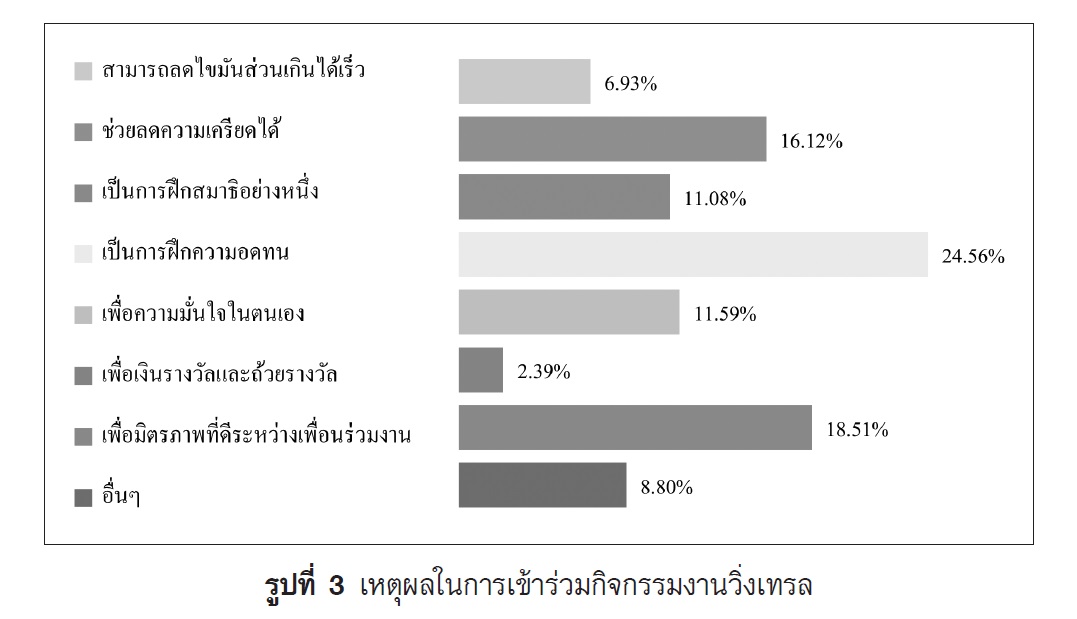ส่วนประสมทางการตลาดที่มีอิทธิพลต่อการส่งเสริมการท่องเที่ยวเชิงกีฬาของกิจกรรมงานวิ่งเทรล
Main Article Content
บทคัดย่อ
ปัจจุบันผู้คนส่วนใหญ่มีแนวโน้มในการแสวงหาที่จะปฏิบัติกิจกรรมกีฬากลางแจ้ง โดยเฉพาะอย่างยิ่งในสิ่งแวดล้อมที่ใกล้ชิดกับธรรมชาติ อากาศที่บริสุทธิ์ ซึ่งปัจจุบันองค์กรที่เกี่ยวข้องในการจัดกีฬากำลังค้นหาสถานที่ใหม่ที่ไม่เพียงแต่ดึงดูดนักกีฬา แต่ยังสามารถเพิ่มจำนวนผู้ชมและผู้ติดตาม
วัตถุประสงค์ : การศึกษาครั้งนี้มีจุดมุ่งหมายเพื่อศึกษาปัจจัยส่วนประสมทางการตลาดที่มีอิทธิพลต่อการตัดสินใจของผู้เข้าร่วมกิจกรรมงานวิ่งเทรลในมุมมองของการส่งเสริมการท่องเที่ยวเชิงกีฬา
วิธีดำเนินการวิจัย : กลุ่มตัวอย่างเป็นผู้เข้าร่วมกิจกรรมงานวิ่งเทรล วิ่งปลุกภูกระดึง (Phu Kradueng Wake Up Run) จำนวน 296 คน โดยการสุ่มเลือกแบบเจาะจง เครื่องมือที่ใช้เป็นแบบสอบถามทำการวิเคราะห์ข้อมูลโดยหาค่าความถี่ ค่าร้อยละ หาค่าเฉลี่ย และค่าส่วนเบี่ยงเบนมาตรฐาน
ผลการวิจัย : ผู้เข้าร่วมกิจกรรมงานวิ่งเทรล มีความคิดเห็นถึงส่วนประสมทางการตลาดโดยรวมทั้ง 7 ด้านอยู่ในระดับมากที่สุด มีค่าเฉลี่ย 4.25±0.80 และเมื่อพิจารณารายด้านโดยเรียงลำดับจากค่าเฉลี่ยมากไปหาน้อย ได้แก่ ปัจจัยด้านบุคลากร ปัจจัยด้าน ราคา ปัจจัยด้านการนำเสนอลักษณะทางกายภาพ ปัจจัย ด้านสถานที่ ปัจจัยด้านกระบวนการให้บริการ ปัจจัย ด้านการส่งเสริมการตลาด และปัจจัยด้านผลิตภัณฑ์ และบริการ ตามลำดับ
สรุปผลการวิจัย : ปัจจัยด้านบุคลากร ปัจจัยด้านราคา ปัจจัยด้านการนำเสนอลักษณะทางกายภาพ และปัจจัยด้านสถานที่ เป็นปัจจัยที่มีคะแนนมากที่สุด 4 อันดับแรก ดังนั้น ผู้ประกอบการจัดกิจกรรมงานวิ่งเทรล สามารถนำผลการศึกษาไปเป็นแนวทางในการปรับกลยุทธ์ทางการตลาดให้มีประสิทธิภาพยิ่งขึ้น โดยเน้นที่ปัจจัยเหล่านี้ เพื่อสร้างความได้เปรียบในการแข่งขันกับคู่แข่งและพัฒนา ผลิตภัณฑ์หรือบริการให้ตรงกับความต้องการของผู้ร่วมงาน
Article Details
เอกสารอ้างอิง
Bodin, M., and Hartig, T. (2003). Does the outdoor environment matter for psychological restoration gained through running? Psychology of Sport Exercise, 4, 141-153.
Bond, K. A., and Batey, J. (2005). Running for their lives: A qualitative analysis of the exercise experience of female recreational runners. Women in Sport and Physical Activity, 14, 69-82.
Bourdeau, P., Corneloup, J., and Mao, P. (2002). Adventure sports and tourism in the french mountains: dynamics of change and challenges for sustainable development. Current Issues in Tourism, 5, 22-32.
Bowler, D. E., Buyung-Ali, L. M., Knight, T. M., and Pullin, A. S. (2010). A systematic review of evidence for the added benefits to health of exposure to natural environments. BMC Public Health, 10, 456.
Brymer, E., Downey, G., and Gray, T. (2009). Extreme sports as a precursor to environmental sustainability. Journal of Sport and Tourism, 14, 193–204.
Cavaco, C. (1995). Rural tourism: The creation of new tourist spaces. European Tourism: Regions, Spaces and Restructuring, 127-149.
Cole, D. N. (2004). Impacts of hiking and camping on soils and vegetation: A review. Environmental Impacts of Ecotourism, 41,60.
Conboy, J. K. (1994). The effects of exercise withdrawal on mood states in runners. Journal of Sport Behavior, 17, 188.
Daniels, M. J., and Norman, W. C. (2003). Estimating the economic impacts of seven regular sport tourism events. Journal of Sport and Tourism, 8, 214-222.
Duglio, S., and Beltramo, R. (2017). Estimating the economic impacts of a small-scale sport tourism event: The case of the italo-swiss mountain trail collontrek. Sustainability, 9, 343.
Gammon, S., and Robinson, T. (2003). Sport and tourism: a conceptual framework. Journal of Sport and Tourism, 4(3), 8-24.
Getz, D. (2008). Event tourism: definition, evolution, and research. Tourism Management, 29, 403-428.
Hinch, T., and Ramshaw, G. (2014). Heritage sport tourism in Canada. Tourism Geographies, 16, 237–251.
Hoye, R., and Parent, M. M. (2016). The SAGE handbook of sport management. SAGE: Thousand Oaks.
Jeenapak, V. (2012). Domestic tourists satisfaction towards the erawan national park in kanchanaburi. Master’s Thesis, Srinakharinwirot University.
Kotler, P. (2003). Marketing management. New Jersey: Prentice-Hall.
Krein, K. J. (2014). Nature sports. Journal of the Philosophy of Sport, 41, 193-208.
Kuiapai, K. (2009). Cultural tourism : A case study of ban luang nua, luang nua sub-district, doi saket district, chiang mai province. Master’s Thesis, Chiang Mai University.
LaChausse, R. G. (2006). Motives of competitive and non-competitive cyclists. Journal of Sport Behavior, 29, 304-314.
Lamont, M., and Kennelly, M. (2012). A Qualitative exploration of participant motives among committed amateur triathletes. Leisure Sciences, 34, 236-255.
Malchrowicz-Mósko, E., Botiková, Z., and Poczta, J. (2019). “Because we don’t want to run in smog”: Problems with the sustainable management of sport event tourism in protected areas (A case study of national parks in poland and slovakia). Sustainability, 11, 325.
Marion, J. L., and Leung, Y. F. (2011). Indicators and protocols for monitoring impacts of formal and informal trails in protected areas. Journal of Tourism and Leisure, 17, 215-236.
Masterman, G. (2014). Strategic sports event management, Routledge: Abingdon, Oxon.
McCarville, R. (2007). From a fall in the mall to a run in the sun: One journey to ironman triathlon. Leisure Sciences, 29, 159-173.
Ogles, B. M., and Masters, K. S. (2000). Older vs. younger adult male marathon runners: Participative motives and training habits. Journal of Sport Behavior, 23, 130-143.
Puttivisit, P. (2009). Guidelines for tourism development of phitsanulok province. Master’s Thesis, Chulalongkorn University.
Ramshaw, G. (2014). Sport, heritage, and tourism. Journal of Heritage Tourism, 9, 191-196.
Ramshaw, G., and Gammon, S. (2005). More than just Nostalgia? Exploring the heritage/sport tourism Nexus. Journal of Sport and Tourism, 10, 229-241.
Suwuttikul, T. (2009). Readiness and potential of ranong provincial administration organization in historical tourism promotion. Master’s Thesis, Khon Kaen University.
Tangkaew, W. (2011). Cultural tourism management in chiangkhan community, chiangkhan district, Loei province. Master’s Thesis, Chulalongkorn University.
Torbidoni, E. I. F., Seguí Urbaneja, J., and Inglés Yuba, E. (2015). Profiling participants of sporting events in the natural environment: Trails running races. In Sustainable Development of Sports Tourism; AnnalesUniversity Press: Koper, Slovenia, 185-194.
Wilson, R. (2006). The economic impact of local sport events: Significant, limited or otherwise? A case study of four swimming events. Managing Leisure, 11, 57-70.


